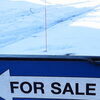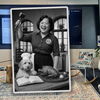Image is everything | Maine consumer products companies find that package design has a direct impact on sales
The problem was the company's packaging, which Mad Gabs had tried hard to make clever through unusual product names, bright colors and hand-drawn illustrations.
What Mad Gabs thought was clever, though, was actually just confusing. People didn't know that "Elephant Lube" was a skin moisturizer. They couldn't tell if the cartoony labels meant Mad Gabs' lip balms were for kids or adults. The cool metal bottle Melchionda had picked out for the company's liquid moisturizer had some customers thinking it was air freshener or liquid soap.
Last year, with sales at a plateau, Melchionda couldn't ignore those opinions anymore. "Our target market was unclear, our uses were unclear and our product names were unclear," says Melchionda. "You can't get very far in business that way."
So Melchionda let go of her fondness for the original packaging and set out to create a whole new look for Mad Gabs' product line. After nearly a year of planning and design work, the company this summer revealed a new logo and packaging ˆ centered on an illustration of a free-spirited woman dancing across hand-painted circles of color ˆ that it hopes will appeal to its core female audience and create a unified look for all the company's products, yet still evoke the playfulness of the original packaging.
Finding the right packaging is a challenge that every consumer product manufacturer has faced, or will face, in order to survive in what marketing experts say is an increasingly cluttered retail universe. Overwhelmed shoppers typically don't even glance at one-third of the products on a store's shelf, according to marketing research company Perception Research Services in Fort Lee, N.J. The products lucky enough to get a look don't hold shoppers' attention for more than five seconds or so. But since marketers estimate that anywhere from 60% to 80% of all purchase decisions are made in the store, it's clear that packaging sells.
For some companies, that's made good packaging the single most important piece of their marketing strategy. "If you're in that one-third of products that shoppers never see, you're in trouble," says Eliot Young, founder and chairman of Perception Research Services, "especially if you're a smaller company that doesn't have the big advertising dollars to market yourself elsewhere."
Count South Portland-based beauty products maker Casco Bay Gardens in that latter category. Like Mad Gabs, Casco Bay Gardens recently unveiled a new look and packaging scheme for its key products, Lobsterman's Balm skin moisturizer and Cool Kiss lip balm. (The health and beauty category is one of the retail sectors in which strong packaging is most important, say marketing experts.) But while Melchionda managed to grow her company for 13 years before realizing the limitations of her packaging, Casco Bay Gardens founder Ghislaine Berube is hoping her new, boldly colored packaging with stylized nautical graphics will help her turn what had been a hobby into a full-time business ˆ and help define her brand from the outset. "You have to look like you've got your act pulled together," says Berube. "When you're printing your labels on the inkjet printer, it's just not pulled together."
Packaging a personality
The quest to impress with packaging has been good news for local designers and marketing firms. A thorough design process can take several months and require about $5,000 for the design work alone, according to Christopher Duval, president of McCabe, Duval & Associates in Portland, who worked with Casco Bay Gardens on the company's new packaging.
At the same time that shelf clutter has made packaging more important, packaging technology also has advanced, giving designers a host of creative new options such as metallic inks, boxes in any kind of configuration and contoured cans and bottles (think the Heineken "keg" can, or Guinness Pub Draught in bottles).
But those options can be dangerous to a company trying to decide exactly how to stand out on the shelf ˆ you don't want to just follow a trend that doesn't match your product. Then there's the scary proposition of abandoning your established design and brand to try something new, which may end up turning off existing customers. "It should be scary. You absolutely can screw it up," says Glenn Rudberg, founding partner of Ethos Marketing and Design in Portland, who worked on Mad Gabs' new packaging. "I definitely counsel people to think about the changes they are making, and to think about the target audience they're trying to reach."
That's why both Rudberg and Duval say that packaging design starts with careful evaluation of the company's brand image. (See "To thine own brand be true," p. 24.) The combination of form, graphics, logos and text on product packaging needs to convey the company's personality. For Duval and Berube, a new look for Lobsterman's Balm had to be fun, to echo's Berube's own personality. "I flatter myself and think that I have a good sense of humor," says Berube, "So the product has to be a little cheerful and friendly, and grab the eye that way."
Mad Gabs, which always trafficked in fun and playfulness, had to figure out what else its brand image needed to convey. Working with Ethos, Melchionda performed a complete brand analysis, identifying her products' most important attributes and features ˆ such as using all-natural ingredients ˆ as well as the more squishy "feeling" of the company. "I definitely had to stop and take stock in a way I never could before because I was just building the business," Melchionda says. "I felt like I was in school."
With the brand image clearly defined, though, a company is in a better position to determine exactly what audience its packaging should target. Mad Gabs had learned that its ambiguous packaging had hurt sales, but the company also knew from an online survey that 95% of its retail customers were women. The obvious solution was to make the new packaging expressly feminine.
For Berube, who is trying to introduce a new brand into the skin- and lip-care category, it was important to appeal to as many customers as possible. Plus, with a name like Lobsterman's Balm, she thought it made sense to make her packaging as gender- and age-neutral as possible.
A little something extra
Once a company knows its brand image and the customers it's courting, it has to develop the images that fit those characteristics ˆ a step where the science of market research meets the art of design. Sometimes, a product or company name gives the designers a good starting point. For example, the name Lobsterman's Balm allowed McCabe, Duval to focus on a nautical packaging theme. The company showed Berube about six different variations on the theme before she settled on a look built around a goofy lobster character and tall seaweed fronds. That lobster, along with a bold color scheme that contrasts bright green with darker red and purple, also serves as the unifying theme across all of Casco Bay Gardens' products ˆ an important factor in an effective packaging strategy (see "All wrapped up," p. 30).
For Mad Gabs' new image, the company looked at more than a dozen concepts, ranging from hippie to sophisticated, very young to very adult, and even some that retained the troublesome elephant. Eventually, Melchionda gravitated toward the dancing woman image, but even then had local illustrator Susan Russell run through about eight different versions before settling on the one now on the company's labels.
Besides a new logo and colors, though, Mad Gabs used the redesign process to change some of its containers as well. The company's lip lubes now come in a slightly larger, easier-to-open tin; the liquid moisturizer is in clear bottle, rather than the metal one that had caused so much confusion; and soy wax candles are now in a glass jar rather than a tin, because customers had said they wanted to see the flame as the candle burned down. The new lip lube tins didn't fit in Mad Gabs' existing display racks ˆ another factor to consider in a packaging redesign ˆ but as part of the process the company redid all its displays, as well.
Thinking about alternative container ideas can be an important part of a packaging design strategy, says Leslie Evans, founder of Leslie Evans Design Associates in Cape Elizabeth. Over the years, as her firm designed packaging for local companies such as L.L. Bean and Stonewall Kitchen, as well as national brands including Timex, Timberland and Disney, she's seen how specially shaped boxes or unique twists on traditional packaging work alongside logos, labels and text. "When a package can give you something extra, like a box you can keep, people tend to feel a little better, or that they're getting more for what they're paying," says Evans.
For example, when Stonewall Kitchen hired her to design packaging for its bottled oils and vinegars in the late 1990s, the gourmet oil market was crowded with competitors. To help Stonewall's products stand out, Evans added a thin wooden hangtag around the bottle's neck, laser-engraved with the Stonewall logo and the type of oil or vinegar inside, that's become one of the company's signature features.
Keep it simple
As Ethos Marketing and Design's Glenn Rudberg notes, though, redesigning a company's packaging can be risky.
The most common mistake is cluttering a package with too many words or images. It's an understandable impulse, since packaging often is a small company's primary marketing tool. But the best packaging should convey one or two key messages on the front, according to Rudberg; it can use visual cues to help convince the shopper to turn the package over for more information.
Another common mistake is to pick a color scheme that is "owned" by a large competitor, the way Kodak owns yellow and black, say marketers. Though some smaller companies believe echoing the look of a large, national brand can help shoppers understand their product and its function, looking too much like a bigger competitor usually just makes the product seem like a knock-off, which makes shoppers skeptical, according to Perception Research Services.
With all the potential pitfalls, it's essential that a company perform consumer research on its packaging designs before finalizing them. The problem, of course, is that smaller Maine companies often can't afford to host formal focus groups on top of the money they're spending on packaging redesign. (Neither Melchionda nor Berube would disclose how much they spent on the redesign.) But for companies working with a small budget, even an informal focus group is better than nothing, says Duval.
For example, Berube couldn't afford a focus group for her new Lobsterman's Balm packaging, but she took the design to three local retailers and asked them how they thought it would look on their shelves, and if they thought it would sell. She also sought feedback on the designs from her friends and family, which was helpful in general, but not as effective as talking to retailers. "If you give people an option to have an opinion, they want to find something wrong with [the design]," says Berube.
Mad Gabs took a similar low-cost approach to its market research, though the company was able to solicit feedback from dozens of its existing retail clients and many of those wholesale buyers who had complained about the original packaging. Melchionda also did some guerilla consumer opinion research, spending an afternoon in Boston's Prudential Center and asking passers-by what they thought of images on the new designs. Some feedback that day resulted in Mad Gabs going through yet another iteration of the dancing woman illustration, says Melchionda.
The ultimate test for new packaging, though, is actual sales. And both Mad Gabs and Casco Bay Gardens say they've seen immediate response from retailers and shoppers. Berube estimates she's landed 50 new clients since introducing the new look this summer, and says she is hearing positive feedback from wholesale buyers at trade shows. She's already working on a candle and shaving cream, which will carry the same distinctive look, to fill out her company's product line.
Mad Gabs had a similar experience at this summer's gift market shows, with nearly all buyers and customers calling the new packaging a major improvement. Though she hasn't tallied up exactly how many new orders the company received, Melchionda says that orders were evenly split between new clients and older customers, some of whom had stopped carrying the line years ago.
Though the initial feedback is good, Melchionda expects it will take at least a year to fully gauge the impact of the packaging redesign, since it will take Mad Gabs' sales representatives some time to meet with all their accounts and for retail re-orders to come in ˆ assuming the packaging does its job attracting those female customers.
In fact, the focus needs to be on the long term, say packaging experts. After all, packaging, like any other marketing, can only carry a company so far. "Good packaging will only help a customer try something once," says Evans. "After that, the product has to live up to the packaging."










Comments